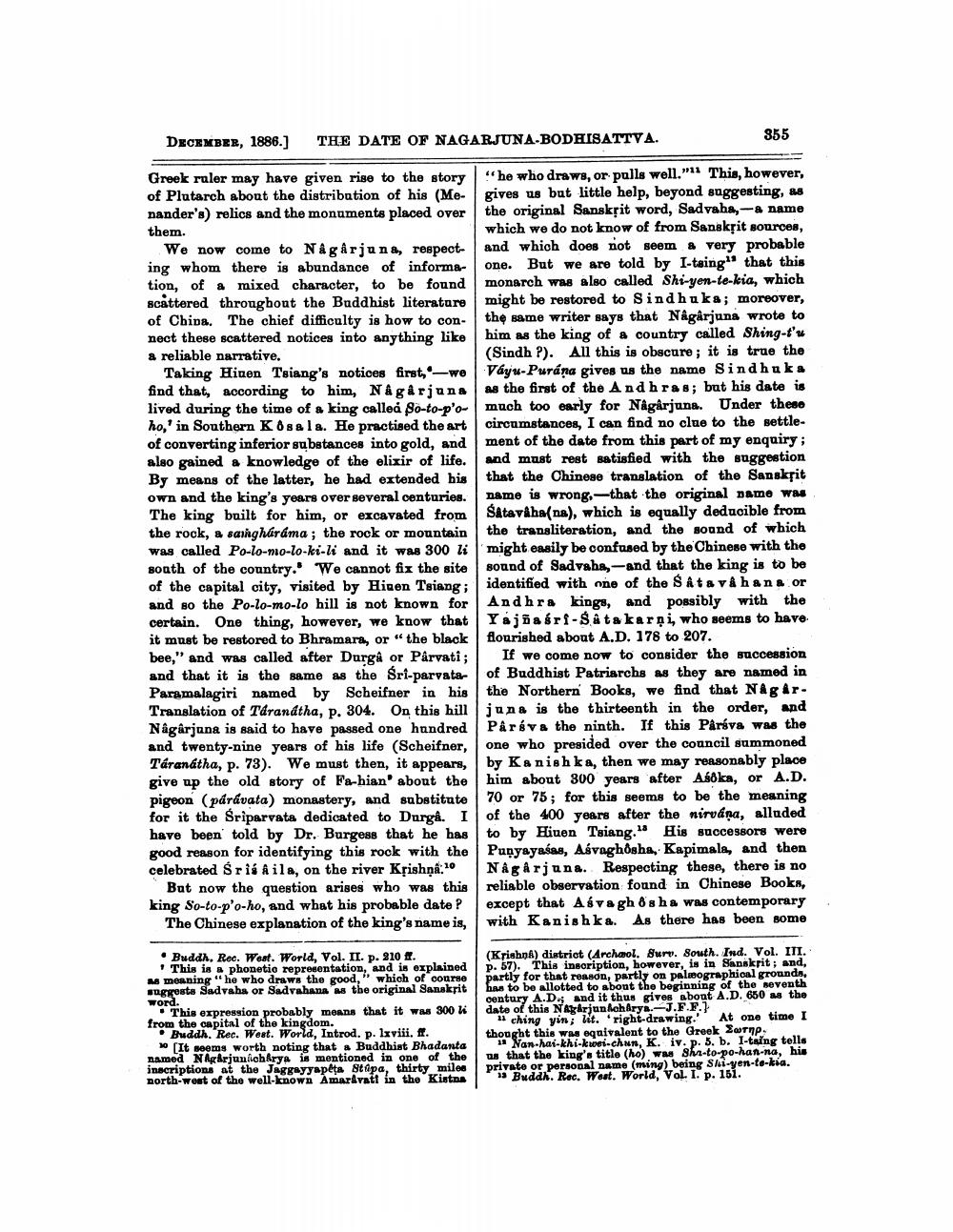________________
DECEMBER, 1886.]
THE DATE OF NAGARJUNA-BODHISATTVA.
855
Greek ruler may have given rise to the story "he who draws, or pulls well." This, however, of Plutarch about the distribution of his (Me- gives us but little help, beyond suggesting, as nander's) relics and the monuments placed over the original Sansksit word, Sadvaha,-& name them.
which we do not know of from Sanskrit sources, We now come to Nagarjuna, respect- and which does not seem a very probable ing whom there is abundance of informa- one. But we are told by I-tsing" that this tion, of a mixed character, to be found monarch was also called Ski-yen-te-kia, which scattered throughout the Buddhist literature might be restored to Sindhuka; moreover, of China. The chief difficulty is how to con- the same writer says that Nagarjuna wrote to nect these scattered notices into anything like | him as the king of a country called Shing-t'u & reliable narrative.
(Sindh P). All this is obscure; it is true the Taking Hinen Tsiang's notices first, we Váyu-Purána gives us the name Sindhuka find that, according to him, Nagarjuna as the first of the Andhras; but his date is lived during the time of a king calleå So-to-p'o much too early for Nagarjuna. Under these ho,' in Southern Kosa la. He practised the art circumstances, I can find no clue to the settleof converting inferior substances into gold, andment of the date from this part of my enquiry : also gained a knowledge of the elixir of life. and must rest satisfied with the suggestion By means of the latter, he had extended his that the Chinese translation of the Sanskrit own and the king's years over several centuries. name is wrong.--that the original name was The king built for him, or excavated from Sataváha(na), which is equally deducible from the rock, a saingháráma; the rock or mountain the transliteration, and the sound of which was called Po-lo-mo-lo-ki-li and it was 300 l might easily be confused by the Chinese with the south of the country. We cannot fix the site sound of Sadvahs, -and that the king is to be of the capital city, visited by Hinen Tsiang; identified with one of the Ata vihana or and so the Po-lo-mo-lo hill is not known for Andhra kings, and possibly with the certain. One thing, however, we know that Yajiasri-Satakarņi, who seems to have it must be restored to Bhramara, or “the black flourished about A.D. 178 to 207. bee," and was called after Durgâ or Pârvati; If we come now to consider the succession and that it is the same as the Sri-parvata of Buddhist Patriarchs as they are named in Paramalagiri named by Scheifner in his the Northern Books, we find that Någår. Translation of Taranátha, p. 304. On this hill juna is the thirteenth in the order, and Nagarjuna is said to have passed one hundred Parsva the ninth. If this Påráva was the and twenty-nine years of his life (Scheifner, one who presided over the council summoned Táranátha, p. 73). We must then, it appears, by Kanishka, then we may reasonably place give up the old story of Fa-hianabout the him about 300 years after Asoka, or A.D. pigeon (párávata) monastery, and substitute 70 or 75; for this seems to be the meaning for it the Sriparvata dedicated to Durgå. I of the 400 years after the nirvana, alluded have been told by Dr. Burgess that he has to by Hiuen Tsiang. His successors were good reason for identifying this rock with the Panyayasas, Ašvaghosha, Kapimala, and then celebrated Sri Aila, on the river Krishna:10 Nagarjuna. Respecting these, there is no
But now the question arises who was this reliable observation found in Chinese Books, king So-to-p'o-ho, and what his probable date P except that Asvagh 8sha was contemporary
The Chinese explanation of the king's name is, with Kanishka. As there has been some
• Buddh. Rec. West. World, Vol. II. p. 210.
This is a phonetic representation, and is explained M meaning "he who draws the good," which of course suggests Sadvahs or Sadvahana As tbe original Sanskrit word.
This expression probably means that it was 300 W from the capital of the kingdom.
Buddh. Rec. West. World, Introd. p. lxviii. 1.
(It seems worth noting that Buddhist Bhadanta named Nagarjunacharya is mentioned in one of the inscriptions at the Jaggayyapeta Stipa, thirty miles north-West of the well-known Amardratt in the Kistna
(Krishna) district (Archaol. Sury. South. Ind. Vol. III. P. 57). This inscription, however, is in Sanskrit ; and, partly for that reason, partly on paleographical grounds has to be allotted to about the beginning of the seventh century A.D., and it thus gives abont A.D. 650 as the date of this Nagarjun Roh Arya.-J.F.F.
uching yin; hit. right-drawing. At one time I thought this was equivalent to the Greek Sarnp.
u Nan-hai-khi-ksei-chun, K. iv. p. 5. b. I-tsing tells us that the king's title (ho) was sh-to-po-han-na, his private or personal name (ming) being Shi yen-te-kia.
» Buddh. Rec. Woat. World, Vol. I. p. 161.




